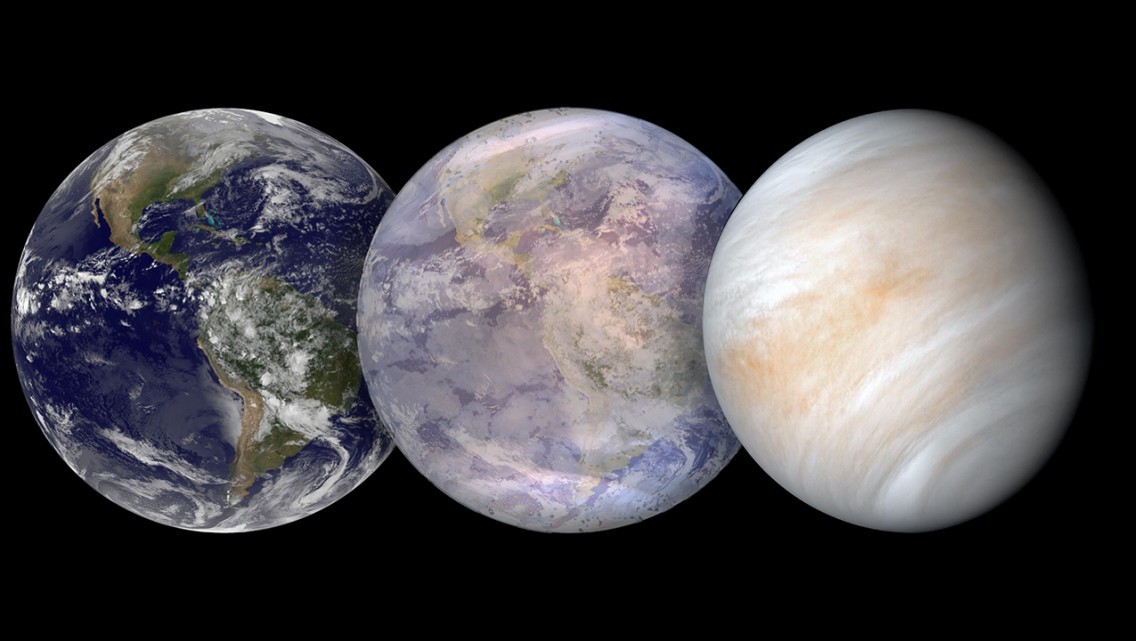James Webb Space Telescope could determine if nearby exoplanet is habitable
What does it take to turn a habitable planet into a world more like Venus?

A rocky exoplanet orbiting a red dwarf star 98 light-years away could hold the secret about how likely it is for planets like Earth to transform into inhospitable worlds like Venus.
The exoplanet, named LP 890-9c (also known as SPECULOOS-2c), was discovered in September 2022. It has a diameter 40% greater than Earth's and orbits its star every 8.5 Earth days at a distance of just 1.7 million miles (2.8 million kilometers). The red dwarf, though, is small and cool, meaning that temperatures can be clement even close to the star. Indeed, LP 890-9c is located near the inner edge of the star's habitable zone, which describes the distance around a star where a planet with an Earth-like atmosphere can support liquid water on its surface.
New research led by Lisa Kaltenegger, director of the Carl Sagan Institute at Cornell University, has modeled the possible climatic and atmospheric states that LP 890-9c could be in, and how the James Webb Space Telescope could distinguish between them.
Related: James Webb Space Telescope — A complete guide
LP 890-9c's position in its planetary system is analogous to Venus' location in our solar system, which is also at the inner edge of the habitable zone. In principle, a planet at Venus' location can remain habitable, but at some point in its 4.5-billion-year history, Venus got trapped within the feedback loop of a runaway greenhouse effect. Any water Venus once had on its surface boiled away, and the planet was left with a thick carbon-dioxide atmosphere.
However, not all planets on the inner edge of the habitable zone will necessarily evolve the same way that Venus has. For one, Venus does not have its own magnetic field to ward off the solar wind, the stream of charged particles flowing from the sun. This made it easier for the solar wind to carry away hydrogen atoms that were split from water molecules by ultraviolet light from the sun, thus depleting the planet of water. If LP 890-9c has a strong magnetic field, it may be able to ward off its star's stellar wind and hold onto the water vapor in its atmosphere.
"Looking at this planet will tell us what's happening on the inner edge of the habitable zone — how long a rocky planet can maintain habitability when it starts to get hot," Kaltenegger said in a statement.
Breaking space news, the latest updates on rocket launches, skywatching events and more!
Kaltenegger's team modeled the planet based on its mass and radius, both of which astronomers have measured. The models also incorporated assumptions about the planet's chemical makeup, its surface temperature and pressure, the depth of its atmosphere and the amount of cloud present. These latter factors are currently unknown. Indeed, the planet could be airless and cratered for all we know, which is a strong possibility given that red dwarfs are often prone to violent flares that could strip an atmosphere from a nearby orbiting world.
The team produced five different models describing what LP 890-9c might be like. These ranged from an Earth-like planet but hotter, through various degrees of atmospheric water vapor content and levels of greenhouse effects, culminating in the final model resembling hellish Venus with its suffocating carbon dioxide.
A separate study, led by Jonathan Gomez Barrientos of the California Institute of Technology, shows that JWST would only need to observe three transits of LP 890-9c across the face of its host star to confirm a steamy, water-rich atmosphere; eight transits to gather enough data to determine whether LP 890-9c is more like Venus; and 20 transits to find evidence of the still-habitable hot Earth scenario. Since the planet transits its star every 8.5 Earth days, the measurements could in principle take just six months to make.
"This planet is the first target where we can test these different scenarios," said Kaltenegger. "If it's still a hotter Earth — hot, but with liquid water and conditions for life — then the inner edge of the habitable zone [around all stars] could be teeming with life."
JWST cannot directly detect water on the planet's surface, but it could determine whether the atmosphere's composition would suit the presence of liquid water.
Even if LP 890-9c turns out to be too hot for life, the findings could teach us about the fate of our own planet, Earth. As the sun ages, it will steadily grow brighter and warmer; within about a billion years' time it will have made Earth too hot for life to survive, and the oceans will evaporate. Studying a planet other than Venus that has already gone through this phase, or perhaps even resisted it for now, will help inform us about Earth's own future.
"It will teach us something fundamental about how rocky planets evolve with increasing starlight and about what will one day happen to us and Earth," said Kaltenegger.
The scientists reported their results in two papers published June 21 in the Monthly Notices of the Royal Astronomical Society.
Follow Keith Cooper on Twitter @21stCenturySETI. Follow us on Twitter @Spacedotcom and on Facebook.

Keith Cooper is a freelance science journalist and editor in the United Kingdom, and has a degree in physics and astrophysics from the University of Manchester. He's the author of "The Contact Paradox: Challenging Our Assumptions in the Search for Extraterrestrial Intelligence" (Bloomsbury Sigma, 2020) and has written articles on astronomy, space, physics and astrobiology for a multitude of magazines and websites.
